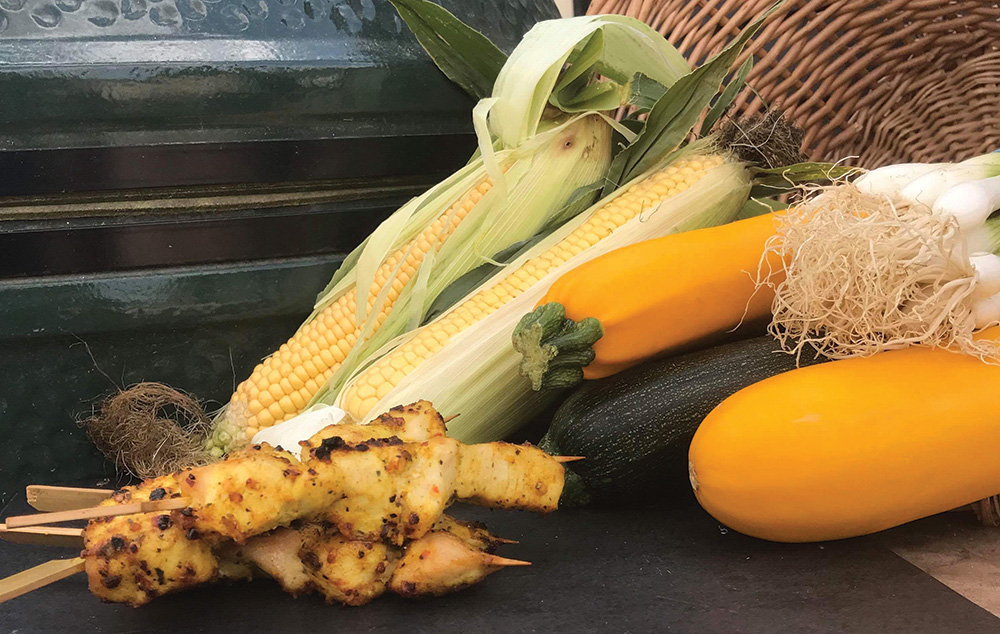The team for The Gog give the low-down on seasonal produce to seek out this month
We all know that eating British fruits and vegetables in season is good for you, as nature cleverly ensures seasonal food contains the nutrients, minerals and trace elements that our bodies need at certain times of the year. This month, we’ve selected two of the most versatile vegetables which can be deliciously prepared in all manner of ways.
As a quick, simple snack served on its own, or as a tasty addition to a variety of meals, sweetcorn with its uniquely delicate, sweet flavour is always a welcome treat. At it’s best when on the cob, September is the prime month to enjoy it. Ours comes from Maldon, just over the Essex border.
The best corn has shiny, plump kernels which are closely packed together and when they’re very fresh, squeezing the kernels will cause them to secrete a milky liquid. Keep it in the fridge to maintain the freshness and, without removing the husk, wrap them in damp kitchen roll to keep the flavour for longer.
Once you’re ready to eat it, you can either eat the corn directly from the cob, or ‘shuck’ the corn to remove it from the cob before serving. This is best done after cooking, as the corn will be easier to remove. To shuck the corn, cut one end off so that the base is flat and place the flat end on a chopping board. With a sharp knife, slice the corn away from the cob.
‘Courgettes are available all year round
but are at their best from June until October’
Our other unsung hero is part of the squash, marrow and cucumber family: courgettes are available all year round but are at their best from June until October, and ours are fresh from the fields in Fenstanton.
The name ‘courgette’ is the adopted French term, whereas in most other European countries and as far as Australia they’re known as ‘zucchini’, which comes from the Italian ‘zucchina’, meaning ‘small squash’.
Steamed, grilled, baked, fried or even eaten raw, courgettes are a versatile summer squash that work just as well with barbecued chicken or fish, in stews or casseroles, grated into salads, or griddled and paired with fresh herbs and lemon.
Go for courgettes that are firm, with bright, shiny and unblemished skin. If a courgette feels soft and looks dull, it usually means it’s no longer fresh.
Low in calories and easy on your waistline, they only have about 2g of carbs per 100g and low glycaemic index (GI). So why not swap your standard pasta for some ‘courgetti’ to lower your carbohydrate intake? Courgettes can grow to nearly a metre long, but the ones with the most flavour are usually the smallest.
For a quick and easy mid-week meal, we love serving sweetcorn and courgette fritters alongside our tasty Indian chicken kebabs, handmade by our in-house butchery team.
The Gog, Heath Farm, Shelford Bottom, Cambridge CB22 3AD
01223 248352 | thegog.com
HOW TO EAT IT
Spicy sweetcorn fritters make a great accompaniment to chicken kebabs
Ingredients
150g plain flour
¼ tsp baking powder
½ tsp sea salt
1tsp ground coriander
½ tsp ground cumin
1tsp sweet paprika
1 egg, lightly beaten
1tsp lemon juice
350g corn kernels, cut from 3 large corn cobs
4 spring onions, thinly sliced
3tbsp chopped coriander
2tbsp olive oil
Method
Place the flour, baking powder, salt, coriander, cumin and paprika in a bowl. Add the egg, lemon juice and 125ml of water and beat to a smooth batter. Add the corn, spring onion and chopped coriander and stir to combine.
Heat the oil in a frying pan over a medium heat and spoon in 2 heaped tablespoons of the mixture for each fritter. Flatten with a spatula and cook for 2 minutes per side until golden and cooked through. Repeat with the remaining mixture.
Indian Kebabs
Cook for 12-15 minutes on 180°C

